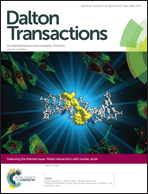Molecular design of cage iron(ii) and cobalt(ii,iii) complexes with a second fluorine-enriched superhydrophobic shell†
Abstract
Pentafluorophenylboron-capped iron and cobalt(II) hexachloroclathrochelate precursors were obtained by the one-pot template condensation of dichloroglyoxime with pentafluorophenylboronic acid on iron and cobalt(II) ions under vigorous reaction conditions in trifluoroacetic acid media. These reactive precursors easily undergo nucleophilic substitution with (per)fluoroarylthiolate anions, giving (per)fluoroarylsulfide macrobicyclic complexes with encapsulated iron and cobalt(II) ions; nucleophilic substitution of the cobalt(II) hexachloroclathrochelate precursor with a pentafluorophenylsulfide anion gave the target hexasulfide monoclathrochelate and the mixed-valence CoIIICoIICoIII bis-clathrochelate as a side product. The complexes obtained were characterized using elemental analysis, MALDI-TOF mass spectrometry, IR, UV-Vis, 57Fe Mössbauer (for the X-rayed iron complexes), 1H, 11B, 13C and 19F NMR spectroscopies and by X-ray diffraction; their redox and electrocatalytic behaviors were studied using cyclic voltammetry and gas chromatography. As can be seen from the single-crystal X-ray diffraction data, the second superhydrophobic shell of such caged metal ions is formed by fluorine atoms of both the apical and ribbed (per)fluoroaryl peripheral groups. The main bond distances and chelate N![[double bond, length as m-dash]](https://www.rsc.org/images/entities/char_e001.gif) C–C
C–C![[double bond, length as m-dash]](https://www.rsc.org/images/entities/char_e001.gif) N angles in their molecules are similar, but rotational elongation (contraction) along the molecular C3-pseudoaxes, accompanied by changes in the geometry of the corresponding MN6-coordination polyhedra from a trigonal prism to a trigonal antiprism, allowed encapsulating Fe2+, Co2+ and Co3+ ions. The nature of an encapsulated metal ion and its oxidation state affect the M–N bond lengths, and, for cobalt(II) clathrochelate with an electronic configuration d7 the Jahn–Teller structural effect is observed as an alternation of the Co–N distances. Pentafluorophenylboron-capped hexachloroclathrochelate precursors, giving stable catalytically active metal(I)-containing intermediates due to the electron-withdrawing effect of their six ribbed chlorine substituents, were found to show moderate electrocatalytic activity in a 2H+/H2 hydrogen-forming reaction. In the case of their ribbed-functionalized sulfide derivatives, the strong electron-withdrawing (per)fluoroaryl groups do not stabilize the reduced electrocatalytically active metal(I)-containing species as their mesomeric effect is absent or substantially decreased by steric hindrances between them.
N angles in their molecules are similar, but rotational elongation (contraction) along the molecular C3-pseudoaxes, accompanied by changes in the geometry of the corresponding MN6-coordination polyhedra from a trigonal prism to a trigonal antiprism, allowed encapsulating Fe2+, Co2+ and Co3+ ions. The nature of an encapsulated metal ion and its oxidation state affect the M–N bond lengths, and, for cobalt(II) clathrochelate with an electronic configuration d7 the Jahn–Teller structural effect is observed as an alternation of the Co–N distances. Pentafluorophenylboron-capped hexachloroclathrochelate precursors, giving stable catalytically active metal(I)-containing intermediates due to the electron-withdrawing effect of their six ribbed chlorine substituents, were found to show moderate electrocatalytic activity in a 2H+/H2 hydrogen-forming reaction. In the case of their ribbed-functionalized sulfide derivatives, the strong electron-withdrawing (per)fluoroaryl groups do not stabilize the reduced electrocatalytically active metal(I)-containing species as their mesomeric effect is absent or substantially decreased by steric hindrances between them.


 Please wait while we load your content...
Please wait while we load your content...